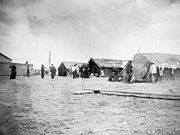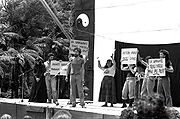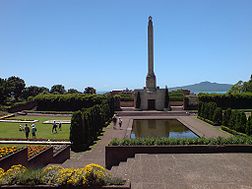
Bastion Point
Encyclopedia



- There is also a Bastion Point near MallacootaMallacoota, Victoria-External links:***...
, VictoriaVictoria (Australia)Victoria is the second most populous state in Australia. Geographically the smallest mainland state, Victoria is bordered by New South Wales, South Australia, and Tasmania on Boundary Islet to the north, west and south respectively....
, AustraliaAustraliaAustralia , officially the Commonwealth of Australia, is a country in the Southern Hemisphere comprising the mainland of the Australian continent, the island of Tasmania, and numerous smaller islands in the Indian and Pacific Oceans. It is the world's sixth-largest country by total area...
.
Bastion Point (Takaparawhau in Māori
Maori language
Māori or te reo Māori , commonly te reo , is the language of the indigenous population of New Zealand, the Māori. It has the status of an official language in New Zealand...
) is a coastal piece of land in Orakei
Orakei
Orakei is a suburb of Auckland city, in the North Island of New Zealand. It is located on a peninsula five kilometres to the east of the city centre, close to the shore of the Waitemata Harbour, which lies to the north, and Hobson Bay and the Orakei Basin, two arms of the Waitemata, which lie to...
, Auckland
Auckland
The Auckland metropolitan area , in the North Island of New Zealand, is the largest and most populous urban area in the country with residents, percent of the country's population. Auckland also has the largest Polynesian population of any city in the world...
, New Zealand
New Zealand
New Zealand is an island country in the south-western Pacific Ocean comprising two main landmasses and numerous smaller islands. The country is situated some east of Australia across the Tasman Sea, and roughly south of the Pacific island nations of New Caledonia, Fiji, and Tonga...
, overlooking the Waitemata Harbour
Waitemata Harbour
The quite famous Waitemata Harbour is the main access by sea to Auckland, New Zealand. For this reason it is often referred to as Auckland Harbour, despite the fact that it is only one of two harbours surrounding the city, and is crossed by the Auckland Harbour Bridge. The Waitemata forms the north...
. The area has significance in New Zealand history for its role in 1970s Māori protests against forced land alienation
Alienation (property law)
Alienation, in property law, is the capacity for a piece of property or a property right to be sold or otherwise transferred from one party to another. Although property is generally deemed to be alienable, it may be subject to restraints on alienation....
by non Māori New Zealanders.
History
The land was occupied by Ngāti WhātuaNgati Whatua
Ngāti Whātua is a Māori iwi of New Zealand. It consists of four hapu : Te Uri-o-Hau, Te Roroa, Te Taoū, and Ngāti Whātua-o-Ōrākei....
, in the period before the colonisation
Colonisation
Colonization occurs whenever any one or more species populate an area. The term, which is derived from the Latin colere, "to inhabit, cultivate, frequent, practice, tend, guard, respect", originally related to humans. However, 19th century biogeographers dominated the term to describe the...
of New Zealand by the British Crown, and was part of important lands for the iwi
Iwi
In New Zealand society, iwi form the largest everyday social units in Māori culture. The word iwi means "'peoples' or 'nations'. In "the work of European writers which treat iwi and hapū as parts of a hierarchical structure", it has been used to mean "tribe" , or confederation of tribes,...
(tribe), overlooking rich fishing and farming areas.
The surrounding land was bought or confiscated by the New Zealand Government for public works
Public works
Public works are a broad category of projects, financed and constructed by the government, for recreational, employment, and health and safety uses in the greater community...
and development over a period stretching from the 1840s into the 1950s.
Occupation
In 1885, the NZ Government built a military outpost at KohimaramaKohimarama
Kohimarama is a coastal residential Auckland City suburb, located to the east of the city.Situated in Eastern Auckland and has a reputation as being relatively wealthy, with many of the homes having some of the best views over Auckland Harbour. According to the 2001 census, Kohimarama has a...
, or Bastion Point, because it commanded good strategic positioning over Waitemata Harbour
Waitemata Harbour
The quite famous Waitemata Harbour is the main access by sea to Auckland, New Zealand. For this reason it is often referred to as Auckland Harbour, despite the fact that it is only one of two harbours surrounding the city, and is crossed by the Auckland Harbour Bridge. The Waitemata forms the north...
. It was not built on Takaparawhau Point, which had earlier been given to the Government for that purpose. In 1886, the Crown used the Public Works Act 1882 to take ownership of 13 acres (5.3 ha) of Bastion Point for this purpose of defence. When, in 1941, the Crown no longer needed Bastion Point for defence, the ancestral Māori land was not returned to its traditional Māori owners but instead gifted to the Auckland City Council
Auckland City Council
Auckland City Council was the local government authority representing Auckland City, New Zealand, and was amalgamated into the Auckland Council on 1 November 2010. It was an elected body representing the 404,658 residents of the city...
for a reserve. (This was the last 60 acres (24.3 ha) of uncommitted land at Orakei that the hapu still hoped to get back.) In 1976, the Crown announced that it planned to develop Bastion Point by selling it to the highest corporate bidder for high-income housing. Joe Hawke
Joe Hawke
Joseph Parata Hohepa Hawke is a former New Zealand politician. He was a member of Parliament for the Labour Party from 1996 to 2002.-Member of Parliament:...
, members of his hapu, and other activists, formed the Orakei Māori Action Committee taking direct action to stop the subdivision. In 1977-1978 the Orakei Māori Action Committee organised an occupation of the remaining Crown land to prevent its confiscation by the Muldoon Government
Third National Government of New Zealand
The Third National Government of New Zealand was the government of New Zealand from 1975 to 1984. It was an economically and socially conservative government, which aimed to preserve the Keynesian economic system established by the First Labour government while also being socially conservative...
. A marae
Marae
A marae malae , malae , is a communal or sacred place which serves religious and social purposes in Polynesian societies...
and housing was built, and crops were grown. A fire in one of the buildings caused the death of a young girl.
A peaceful occupation lasted for 507 days and was finally ended on the 25th May 1978, when 800 police and the New Zealand army were used to forcibly remove the occupiers and destroy the temporary buildings including vegetable gardens and a meeting house, which were constructed to accommodate the living during the protest. Two hundred and twenty two protesters were arrested. The occupation and use of force to end it played a part in highlighting injustices against Māori, and the occupation was a major landmark in the history of Māori protest
Maori protest movement
The Māori protest movement is a broad indigenous rights movement in New Zealand. While this movement has existed since Europeans first colonised New Zealand its modern form emerged in the early 1970s and has focused on issues such as the Treaty of Waitangi, Māori land rights, the Māori language and...
.
In the 1980s New Zealand Government formally apologised and returned the land to Ngāti Whātua with compensation, as part of the Treaty of Waitangi
Treaty of Waitangi
The Treaty of Waitangi is a treaty first signed on 6 February 1840 by representatives of the British Crown and various Māori chiefs from the North Island of New Zealand....
settlement process.
A documentary supporting the protest by filmmakers Merata Mita
Merata Mita
Merata Mita, CNZM was a significant filmmaker in New Zealand as well as a key figure in the growth of the Māori screen industry. Mita was from the Māori tribes of Ngāti Pikiao and Ngāi Te Rangi.-Background:...
, Leon Narbey and Gerd Pohlmann was made about the takeover of Māori land. It is titled "Bastion Point Day 507" and it uses various video footage of the forceful land takeover.
Savage Memorial

New Zealand Labour Party
The New Zealand Labour Party is a New Zealand political party. It describes itself as centre-left and socially progressive and has been one of the two primary parties of New Zealand politics since 1935....
Prime Minister of New Zealand
Prime Minister of New Zealand
The Prime Minister of New Zealand is New Zealand's head of government consequent on being the leader of the party or coalition with majority support in the Parliament of New Zealand...
Michael Joseph Savage
Michael Joseph Savage
Michael Joseph Savage was the first Labour Prime Minister of New Zealand.- Early life :Born in Tatong, Victoria, Australia, Savage first became involved in politics while working in that state. He emigrated to New Zealand in 1907. There he worked in a variety of jobs, as a miner, flax-cutter and...
(March 23, 1872 – March 27, 1940).
External links
- Television footage of Bastion Point eviction, from Te Ara, the Encyclopedia of New Zealand
- Report on the Orakei claim, Waitangi TribunalWaitangi TribunalThe Waitangi Tribunal is a New Zealand permanent commission of inquiry established under the Treaty of Waitangi Act 1975...
- Radio NZ sound bite interviews on the 1970s Bastion Point protest.

